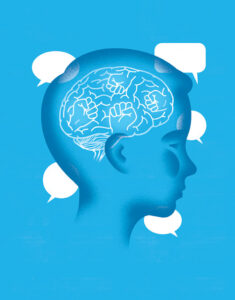‘Social Neuroscience’ course delves into the psychological pain
By Andrew J. Concatelli
Illustrations By Chris Gash
“The children’s rhyme goes, ‘Sticks and stones can break my bones, but names can never hurt me,’ but in fact that’s not true, when you look at how the brain processes the psychological pain of bullying,” says Trinity College Assistant Professor of Neuroscience Sally Bernardina Seraphin, who last year introduced the new “Social Neuroscience” course to the college curriculum. “Psychological pain hurts, in that it activates some of the same areas of the brain as physical pain, like from a paper cut or a punch.”
 A unit in the course that focused on the impact of bullying on the brain teaches Trinity students about how social rejection or isolation can lead to long-term physical and mental health problems. The students, in turn, had the opportunity to deliver these “Bullying in the Brain” lessons to children in local schools and youth organizations through participatory presentations as part of the course’s community learning component. “Learning is interactive and collaborative. That’s what resonates with students of any age,” Seraphin says.
A unit in the course that focused on the impact of bullying on the brain teaches Trinity students about how social rejection or isolation can lead to long-term physical and mental health problems. The students, in turn, had the opportunity to deliver these “Bullying in the Brain” lessons to children in local schools and youth organizations through participatory presentations as part of the course’s community learning component. “Learning is interactive and collaborative. That’s what resonates with students of any age,” Seraphin says.
“Social neuroscience is a newer and rapidly emerging interdisciplinary field that looks at how the brain processes and regulates social functions—that includes everything from processing faces, gestures, and postures, to vocal communication and complex social interactions,” Seraphin says. “For students who want to pursue neuroscience careers, it’s a really important foundation. Other students may find what they learn through studying social neuroscience useful when they go into business, finance, government, and health professions.”
The study of bullying is just one aspect of social neuroscience that connects with Seraphin’s background in research on early maltreatment and trauma. “There’s good literature on the impact of social isolation, social rejection, and loneliness that emerges from bullying on mental health and well-being,” she says. Seraphin has given a conference presentation on the subject and co-wrote a peer-reviewed article for The Journal of Undergraduate Neuroscience Education. Bullying remains a perpetually timely subject, Seraphin says, noting that at the time the inaugural course was being taught, the U.S. Congress was holding a hearing about cyberbullying and bullying in schools.
Seraphin teaches her students that just as there are ways to help treat physical pain, such as with medication, there are also ways to cope with psychological pain, including social support, self-care, and mindfulness. “Loneliness increases the expression of genes involved in inflammation, which contributes to a lot of health problems. By contrast, feeling a part of a community reduces inflammation. This is all part of the mind-body connection,” she says.
 The effects of bullying don’t stay manifest in the brain and body, Seraphin says. “Really bad things can happen to kids who are bullied. Sometimes they stop going to school or don’t perform as well in school, they may become delinquent or may become bullies themselves, and they are more likely to become incarcerated. Some develop mental health problems stemming from the bullying and may even die by suicide. So it seemed really compelling to go out there and teach about these connections between physical pain, psychological pain, and bullying, in terms of where they manifest in the brain, but also how both can be alleviated by self-care and social analgesics or allyship.”
The effects of bullying don’t stay manifest in the brain and body, Seraphin says. “Really bad things can happen to kids who are bullied. Sometimes they stop going to school or don’t perform as well in school, they may become delinquent or may become bullies themselves, and they are more likely to become incarcerated. Some develop mental health problems stemming from the bullying and may even die by suicide. So it seemed really compelling to go out there and teach about these connections between physical pain, psychological pain, and bullying, in terms of where they manifest in the brain, but also how both can be alleviated by self-care and social analgesics or allyship.”
Neuroscience major Dorothy Mansah Anika ’22, of the Bronx, New York, says the course taught her about the brain, social connections, love, neural systems, and more. She notes, “This course examines the complexities of human behavior, its relationships to the environment, and the mechanisms behind social processes and these actions.”
Seraphin joined the Trinity faculty in 2020 wanting to forge connections with the Greater Hartford community and to deepen learning for her students. To accomplish both of those goals, she joined Trinity’s Community Learning Faculty Fellows (CLiFF) program, which introduces faculty to community engagement pedagogy and supports them in designing a community learning component to be taught in an upcoming course. Seraphin focused on the idea of developing what she calls non-disposable assignments or learning objects. The creation of something physical and more permanent that can be used to help teach others—like a game or interactive poster—can help students retain knowledge and can leave more of a lasting impact than an exam or a term paper, Seraphin says.
“They’re not just assignments that students submit for me to read but instead can potentially benefit someone in the community, so there is a greater emotional investment,” Seraphin says. “We don’t want students to be passive receptacles of knowledge. Non-disposable assignments generate knowledge that can be shared with the community, giving their work a lifespan that surpasses the semester. This is a way not only of deepening student learning by giving them an opportunity to apply and perform a service based on the course materials but also is a way to create a bigger impact in the community.”

Students in Seraphin’s class had several opportunities during the spring 2022 semester to deliver their anti-bullying program and to engage younger area students with the learning objects they created. The class members visited the Trinity College Boys & Girls Club of Hartford and took part in April 2022’s on-campus “BBQ and Brains” event hosted by Trinity’s Neuroscience Club—and co-organized by Anika, Alicia Camuy ’22, and Michelle Mordasiewicz ’22—which welcomed students in the Compass Youth Collaborative, whose CEO is Trinity alumna Jacquelyn Santiago Nazario ’00.
At the in-person programs, Trinity students set up several stations designed around different messages and activities. At one station, the Trinity students talked about what bullying means and how it looks in the brain. At another, the younger students wrote anonymously on index cards about their experiences with bullying and dropped them in a fish bowl. Making notes on interactive bulletin boards facilitated conversations about ways to help alleviate social pain or stress.
Seraphin says, “One group of my students developed a game that involves role-playing different bullying scenarios, appropriate for different age groups. The idea was to get to the recognition of when and how to go from being a bystander to an ally.” She adds, “We tried to keep the principles and takeaways simple. We wanted to teach basic neuroscience while communicating the analogy between hurt from bullying and physical pain.”
Through a virtual presentation with students at Hall High School in West Hartford, Seraphin’s class used online versions of the games and interactive bulletin boards and also spoke with the high schoolers about the criminal implications of bullying. Seraphin says she hopes to further develop this program and make it available to after-school programs and public schools.
 Hall math teacher Darcie Hudson-Harriman says that her students were struck by the research they were shown. “Being able to see that the regions of the brain associated with pain are affected from bullying made many students realize the impact bullying has on the body,” she says. “Students learned how they can lessen the physiological impacts of bullying by practicing self-care techniques, as well as how to be an upstander in a safe way. We were so impressed with the thoroughness of the presentations and interactive activities. It was a positive experience that left students feeling hopeful that there are ways to help themselves or other victims.”
Hall math teacher Darcie Hudson-Harriman says that her students were struck by the research they were shown. “Being able to see that the regions of the brain associated with pain are affected from bullying made many students realize the impact bullying has on the body,” she says. “Students learned how they can lessen the physiological impacts of bullying by practicing self-care techniques, as well as how to be an upstander in a safe way. We were so impressed with the thoroughness of the presentations and interactive activities. It was a positive experience that left students feeling hopeful that there are ways to help themselves or other victims.”
Recent graduate Anika says preparing for the high school program led to “fascinating conversations on how our upbringing or the circumstances we find ourselves in have a significant impact on our life and how the brain is involved.” She adds that it was important to teach younger students about the connection between neuroscience and bullying because it raises awareness and emphasizes the need to reassure them that others are available to help, that they can speak up, and that the human brain is resilient. “These resources and this knowledge can prevent a child from the horrifying aspect of being a victim.”
